Urine diversion terra preta toilets are a low cost, dry terra preta sanitation (TPS) systems based on urine diversion and the addition of charcoal producing lasting and highly fertile soils with properties similar to the recently discovered pre-Columbian man-made terra preta soils. The terra preta toilets are based on a three-step process of collection (including urine diversion), lactic acid fermentation (lacto-fermentation) and vermicomposting. Any urine diversion or composting toilet can thus been adapted for TPS. The main advantage of lacto-fermentation is that no gas (e.g. methane) and no odour is produced what makes it particularly interesting for in-house systems even in urban areas. Vermicomposting transforms the carbon and nutrients into the deep black, fertile and stable soil, which also has the potential as a long-term carbon sink.
| المُدخلات | المُخرَجات |
|---|---|
Feriliser, Compost/Biosolids |
Urine diversion terra preta toilets are dry terra preta sanitation (TPS) systems based on urine diversion, lacto-fermentation, the addition of charcoal and vermicomposting to produce lasting and highly fertile soils with properties similar to the terra preta soils (GENSCH 2010 b).
Pre-Columbian native populations generated terra preta soils, literally “black earth”, by incorporating large amounts of charred residues (charcoal) either produced intentionally or as a by-product from human activity into the soil together with nutrient-rich material (GLASER 2006). Nutrient-rich material was used to be human and animal manure (rich in P and N), waste including mammal and fish bones (rich in P and Ca), ash residues of incomplete combustions (rich in Ca, Mg, K, P and charcoal) or plant biomass (e.g. kitchen wastes, compost, algae etc.) (GLASER 2006). It is the addition of charcoal resulting in high contents of black carbon, which gives these soils their black appearance and their unique properties.
Due to its polycyclic aromatic structure, black carbon is chemically and microbiologically stable and persists in the environment over centuries (GLASER et al. 2001). Over the time, it gets partly oxidised and carboxylic groups are produced on the edges of the black carbon backbones (GLASER et al. 2001). The carboxylic groups act as a trap for nutrients in the soil preventing them from being washed out. The nutrients entrapped in the micro pores and cracks in charcoal provide not only necessary elements for plant growth, but also food and a safe housing for the protection form gazing protozoa to beneficial bacteria (O'GRADY & RUSCH 2007).
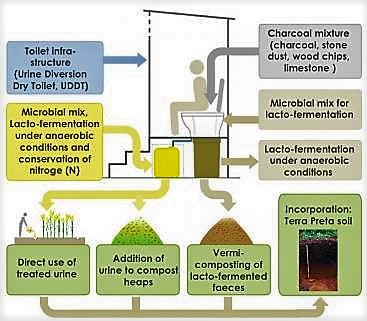
As the backbones of the black carbon remain stable, terra preta has a large potential as a long-term carbon sink: a hectare of meter-deep terra preta can contain 250 tons of carbon as opposed to 100 tones in unimproved soils (GLASER et al. 2001; LEHMANN et al. 2006; GUENTHER 2007).

Many years of research have helped to better understand terra preta soils since they have been discovered. Today, the production of terra preta soils by the co-composting of charcoal is an emerging and promising concept to improve long-term fertility of arid soils and contribute to carbon sequestration from the atmosphere. Terra Preta Sanitation (TPS) is the name of the concept, which aims to use this technology for a safe and recycling-oriented treatment of wastes.
To date, TPS has been scientifically established for kitchen and garden wastes, human faeces and human urine. As a toilet system, TPS could be applied to Urine Diversion Toilets (UDDTs), arborloos, fossa alternas or any other kind of composting toilet. The terra preta toilets are based on a three-step process of collection (including urine diversion), lacto-fermentation and vermicomposting. The products are fertile compost (terra preta) and liquid fertiliser (sanitised urine containing stable nitrogen). The separate collection of urine can be done in a UDDT, arborloo with extra urine collection or any other adapted composting toilet. The terra preta toilets consist thus of basically four elements: A toilet superstructure, which provides shelter for the user and the toilet itself; a urine diversion seat or slab; a urine collection chamber (e.g. a jerry can) and a faeces collection chamber (bucket; vault; etc.).
Toilet superstructure
Any toilet should have a superstructure for two main reasons. First, a toilet should be a place of privacy and give the impression to be safe and cosy. Second the toilet housing has a important effect on the functioning because it protects the toilet from heavy rain, sunshine, wild animals or vandalism and influences the ventilation system, which is crucial for the control of odour and fly breading.
Terra preta toilets process both faeces and urine in an anaerobic process in which no gas and thus no odour is produced. This makes them particularly interesting for larger scale and indoor application (in urban area) (OTTERPOHL 2009; GENSCH 2010 a; FACTURA et al. 2010). Consequently, there is no need for a special ventilation of the collections chamber and ventilation of the toilet can be limited to the circulation of fresh air in the cabinet or the indoor toilet room.
Collection of Urine
The urine can be collected in any container which is air and liquid-tight and can safely be connected to the urine diversion toilet seat or slab. A connection tube generally is introduced into the bottom of the container, so as a minimum of air can enter the tank. About half a litre (for a 20 L jerrican) of the microbial mix (liquid mix of lacto-fermenting bacteria and Bacillus subtilis, see below) should be added to the urine container prior the collection (GENSCH 2010 b).
The microbial mix prevents the bacterial urease process, that hydrolyses urea into ammonia (NH3) and carbon dioxide (CO2) (RECKIN 2010) what is usually happening when urine is conventionally stored (GENSCH 2010 b). As NH3 and CO2 are volatile, these elements are quickly lost to atmosphere, resulting in bad odour and pollution (NH3 can cause acidification and eutrophication when it settles again with the rain, while CO2 is a greenhouse gas). As the bacterial urease process is prevented, no volatile ammonia is produced, resulting in almost no odour, a reduced loss of nitrogen into the atmosphere and the conversion of N in the urine, leading to higher fertilisation potential (RECKIN 2010; GENSCH 2010 b).
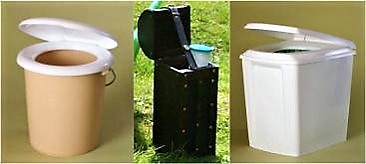
Collection of Faeces
Almost any sealable bucket can be used as a faeces collection chamber. The most important feature of the faeces collection chamber is its air-tightness to make sure that there are anaerobic conditions for lacto-fermentation. The most simple collection chamber is a bucket, placed under a toilet seat. Thus, not only the collection chamber / bucket, should be airtight, but the toilet seat or squatting hole needs to be sealable. After each defecation, a charcoal mix needs to be added to cover the faeces. Charcoal removes the bad odour of the faeces (OTTERPOHL n.y. b) and provides stable organic matter for the terra preta soil production. Sliced-cut wood is used as a bulking agent and to raise the C/N ratio in order to create a substrate, which will be accepted by the earthworms (FACTURA et al. 2010).
To initiate the lacto-fermentation process in the faeces collection chamber/bucket, a few dashes of a lacto-bacilli (Lactobacillus spec.) containing microbial mix can be added after each use (GENSCH 2010). In this case, it is important, that after each use, the toilet seat is sealed again, even thought the system still works with some remaining air (OTTERPOHL 2009). It is also possible to use a bucket for one or two weeks, and then replace it with a new, empty one. The microorganisms are added then to the full bucket, before it is sealed and left aside for the lacto-fermentation process to happen (FACTURA et al. 2010). For an optimal conversion, minimum 4 weeks of lacto-fermentation (both of faeces and urine) are recommended before vermicomposting (OTTERPOHL n.y. b; FACTURA et al 2010). However, faeces can be stored that way over longer periods without the formation of odours or nocuous gases (OTTERPOHL n.y. b).
Charcoal Mix
Terra preta toilets only function properly if the charcoal mix and the microbial mix are regularly added and processed together with the excreta. The mix should contain charcoal (black carbon), stone dust, finely cut wood (or another bulking agent to raise the C/N ratio necessary for vermicomposting) and some limestone or volcanic soil (FACTURA et al. 2010; GENSCH 2010). It can be prepared in advance regarding the local available material and stored beside the toilet to be used after each defecation.
Microbial Mix
The effective mixture of microorganisms needed for the lacto-fermenting process is available commercially (e.g. effective microorganisms, EM). But these mixtures are often expensive and spoil after some weeks as they are manipulated for commercialisation. The easiest way to obtain an effective microbial mix is probably to take an inoculum from Sauerkraut (pickled sour cabbage) liquid (OTTERPOHL 2009; FACTURA et al. 2010).
Dr. Reckin, a German researcher, which is involved in TPS development, has developed a microbe mixture similar to EM, containing a mixture of five microbes namely: Bacillus subtilis, Bacillus mesentericus, Geobacillus stearothermophilus, Azotobacter croococcum and Lactobacillus sp., respectively. This mixture is specifically designed to prepare for vermicomposting and thus may be better suited than commercial effective microorganism or Sauerkraut liquor. Bacillus subtilis is not a lacto-fermentation bacterium per se, and it is probably the combination of lacto-fermentation with some other processes together with the addition of some thin wood particles that is leading to a better compost quality (FACTURA et al 2010).
Dr. Reckin’s mixture is available with him, at the Technical University Hamburg-Harburg (TUHH, Institute of Wastewater Management and Protection, aww, Germany) or from the Xavier University Sustainable Sanitation Center (Philippines).
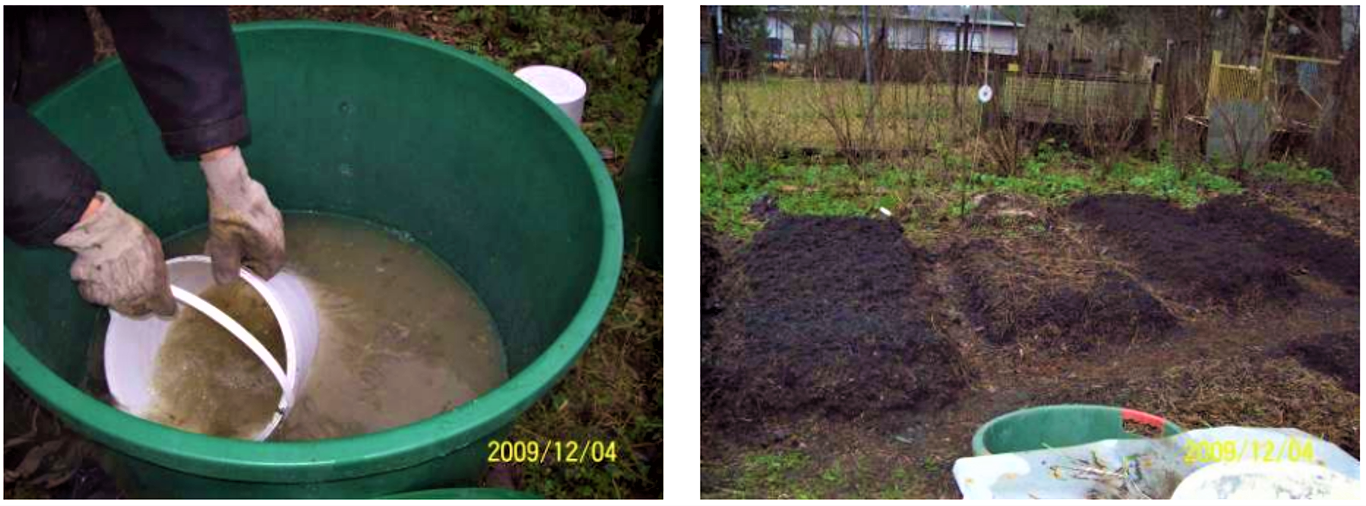
Vermicomposting
After lacto-fermentation of the faeces, these need to be vermicomposted to produced transform the carbon and nutrients into humic acids, clay-humus complexes and other elements, which form the fertile terra preta compost. Vermicomposting is an aerobic decomposition process involving the combined action of earthworms and microorganisms. Both, faeces and urine can be vermicomposted, even though the nitrogen and phosphorus rich lacto-fermented urine can also be used directly as liquid fertiliser after lacto-fermentation. The initial addition of the finely cut wood and the Bacillus subtilis to the microbial mix allows the vermicomposting of faeces without any additional bio-waste (kitchen or garden waste). The final product is nutrient-rich vermi-cast (cast of the earthworms) with properties similar to terra preta (see TPS factsheet).
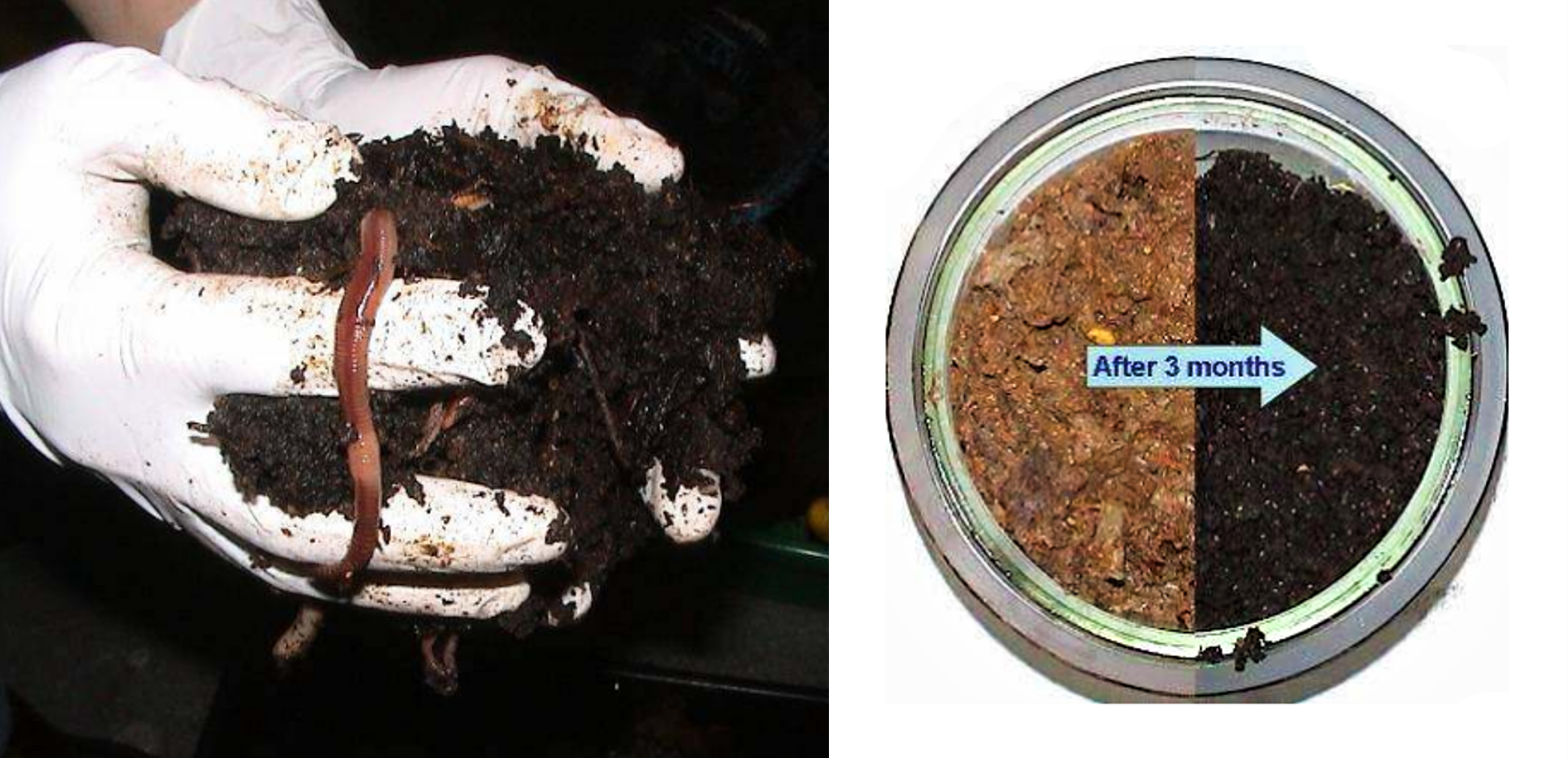
Urine can also be composted on its own by adding a little bit of the microbial mix and mixing with a finely sliced wood source (80%), ground charcoal power (10%) and existing soil (10%) (GENSCH 2010 a). This mix should then be covered with some dry leaves and left beside under regular watering. After about one month (tropical conditions), the heap will convert into a humus-like fertile material with no significant N, P and K losses (GENSCH 2010 a).
TPS is, even though rediscovered from ancient cultures, a rather new technology and still some research is needed for exact estimation of pathogen removal. However, lacto-fermentation is used throughout the world in industry to preserve foods (pathogenic microorganisms are killed when acidity rises) and vermicomposting is a rather well established treatment of kitchen and garden wastes. A recent publication indicates that faecal indicator bacteria are reduced by over 99 %, confirming this assumption (FACTURA et al. 2010).
Terra preta toilets are an interesting option for the adaption of UDDT (urine diversion dry toilets): Not only because the combined process of anaerobic lacto-fermentation and aerobic vermicomposting prevents the emission of ammonia to the atmosphere and loss from urine, but also because the process is expected to hygienise faeces faster and more lasting than simple dehydration (e.g. for helminth eggs). The effect on other more persistent pathogens in faeces like helminth ova (Ascaris lumbricoides) still requires further research.
The costs of terra preta toilets depend on the type of urine diversion or composting toilets it taken as collection units (e.g. UDDT, arborloo, fossa alterna, etc.). As every toilet construction the effective costs depend strongly on the local context, climate and availability of material and work. Terra Preta Toilets could be constructed as a high-tech alternative to conventional sanitation systems in multi-story houses as well as at the household level. The most basic terra preta toilet does not require more than a sealable bucket for faeces; a urinal; the microbial mix; the charcoal mix and space for vermicomposting. Thus there is a high potential for low-cost solutions even though a well-established urine diversion toilet (which is also convenient for woman, children and elderly people) should be considered as the minimal standard for long-term solutions.
Operation and maintenance efforts for terra preta toilets are not very high but crucial for a good functioning of the system. The main task to be done are: checking for air-tightness of the faeces and urine chamber, rinsing urine pipes from deposits (precipitates from the urine); the maintenance of the lacto-fermentation (e.g. addition of charcoal and microbial mix); changing of containers and proceeding of vermicomposting; reuse of products in the garden.
The microbial mix can be kept at the household level and continuously fed and cultivated. Generally the bacteria can be duplicated every 2 days, but they should be fed at least once a week with some water, a sugar source (blended bananas, sugar can juice etc.) and sterilised milk (GENSCH 2010 b). Sugar content in the solution should be around 3 to 5 % (GENSCH 2010 b). The entire solution should be cooked for sterilisation and cooled down before added (GENSCH 2010 b). Bottles, containing the microbial mix have o be clearly labelled and kept away from children.
The lacto-fermentation process should be maintained at least for one month (up to six month, OTERRPOHL n.y. a; FACTURA et al. 2010) in a completely close container before transferring the products to the vermicomposting step or to use the urine. Vermicomposting should be done for three to six month (OTERRPOHL n.y. a; FACTURA et al. 2010).
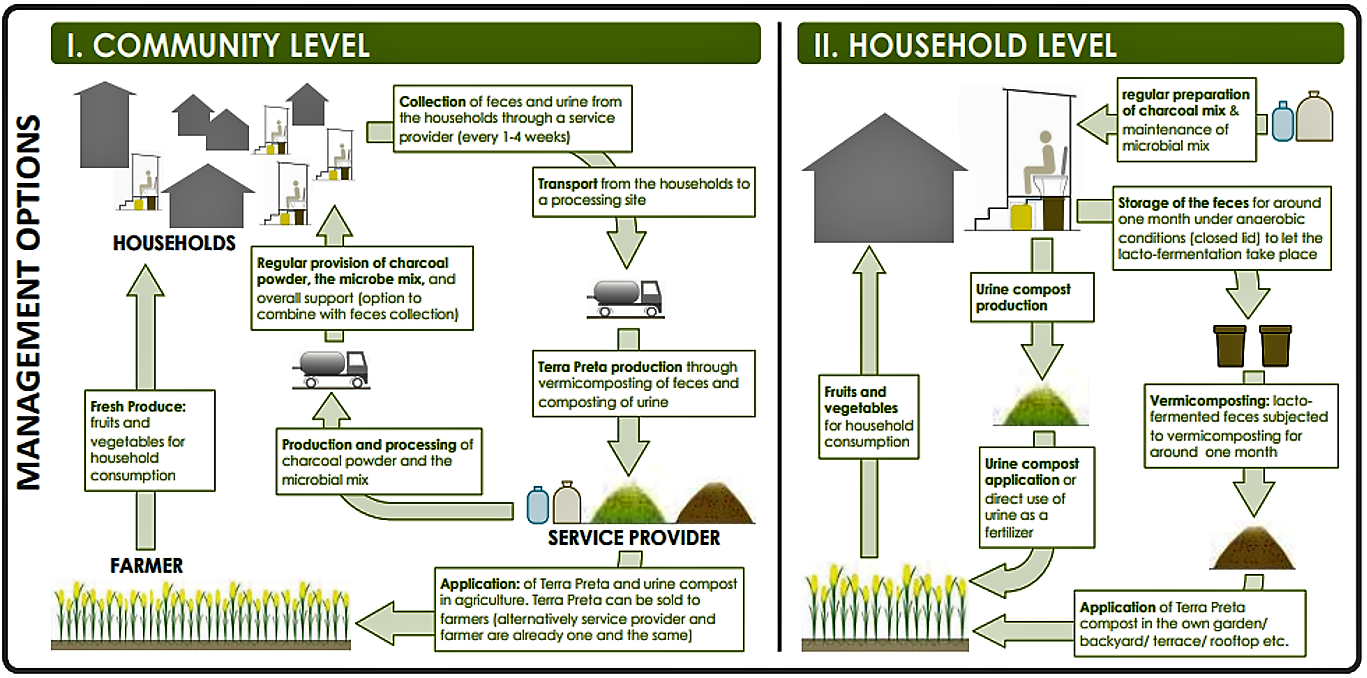
| Working Principle | Urine and faeces are separated in the toilet. Urine is lacto-fermented (a microbial mix is added) in the collection chamber preventing loss of nitrogen. Faeces are equally lacto-fermented after addition of a charcoal mix (containing charcoal, stone-dust, woodchips, etc.). In the final vermicomposting step, a highly fertile compost (terra preta), rich in black carbon, is produced. |
| Capacity/Adequacy | Can be used both at household and community level, urban and rural areas, and has the potential for both, high-tech and low-tech design. |
| Performance | Almost all nutrients and organic matter contained in the urine and faeces are transformed to safe fertiliser. |
| Costs | Depending on context. Very flexible. |
| Self-help Compatibility | Can be constructed at the household level. |
| O&M | Microbe mix needs to be cultivated properly and chambers need to be changed and emptied. Terra preta compost needs to be used. |
| Reliability | Still under research, but high potential. |
| Main strength | No loss of nutrients or organic matter to the atmosphere. |
| Main weakness | Still relatively new. Requires correct cultivation of microbial mix. |
Integration of the anaerobic (lacto-fermenting) dry toilet and vermin-composting promises to be an ideal approach for managing wastes even generated by urban households (FACTURA et al. 2010). Both, kitchen wastes and excreta can be treated producing the highly fertile and carbon sequestrating terra preta. This process can address the problems of soil degradation and food insecurity common in many areas across the world (FACTURA et al 2010).
As lacto-fermentation is an anaerobic process, almost no gases are produced (no methane and no ammonia loss to atmosphere). This makes terra preta toilets particularly interesting for larger scale and indoor application (in urban areas) (OTTERPOHL 2009; GENSCH 2010; FACTURA et al. 2010). Terra preta sanitation may also allow addressing some major challenges to dry sanitation such as urban and sub-urban areas, multi storey houses, or smell problems in the case of large-scale ventilation (OTTERPOHL n.y. b). Therefore, terra preta toilets are promising to design highly resource efficient houses and housing areas with added value in urban agriculture closing regional cycles and improve hygienic conditions and soil fertility in a sustainable manner with the creation of local added value (FACTURA et al. 2010). However, one must also keep in mind that terra preta toilet do require a minimum amount of operation and maintenance from the user.
As long as there is a demand for terra preta and urine-based fertilizers, terra preta toilets and TPS in general can be a sustainable sanitation solution for both household and community level.
Terra Preta Sanitation: re-discovered from an ancient Amazonian civilisation - integrating sanitation, bio-waste management and agriculture
The objective of this study was to investigate the suitability of terra preta sanitation (TPS) systems as an alternative sanitation option. The effects of lactic-aid conditions in urine-separation dry toilets and a subsequent treatment by vermicomposting are assessed. Research focused on analysing standard chemical and biochemical properties of the toilet products to evaluate their stability and maturity, and establish nutrient status.
FACTURA, H. ; BETTENDORF, T. ; BUZIE, C. ; PIEPLOW, H. ; RECKIN, J. ; OTTERPOHL, R. (2010): Terra Preta Sanitation: re-discovered from an ancient Amazonian civilisation - integrating sanitation, bio-waste management and agriculture. المُدخلات: Water Science and Technology, accepted for publication: URL [Accessed: 10.05.2019]a: Terra Preta Sanitation (TPS) Workshop, April 5-8, 2010
b: Terra Preta Sanitation. Overview
Comprehensive and well illustrated factsheet on how lacto-fermentation and vermicomposting can be used to produce valuable fertiliser and terra preta from urine and faeces from diversion dry toilets.
GENSCH, R. (2010): b: Terra Preta Sanitation. Overview. Cagayan de Oro: Xavier University, Sustainable Sanitation Center. [Accessed: 11.05.2010] PDFThe ‘Terra Preta’ phenomenon: a model for sustainable agriculture in the humid tropics
This paper gives a short overview on the historical background and the formation of terra preta in the Amazon region. The composition of terra preta and the importance of charcoal and other ingredients for the formation and their carbon sequestration capacity are discussed. There is an outlook on how to recreate this very useful and nutrient rich type of earth in a synthetic way by mentioning current sources and studies.
GLASER, B. ; HAUMAIER, L. ; GUGGENBERGER, G. ; ZECH, W. (2001): The ‘Terra Preta’ phenomenon: a model for sustainable agriculture in the humid tropics. المُدخلات: Naturwissenschaften: Volume 88 , 37-41. URL [Accessed: 11.05.2019]Carbon sequestration for everybody: decrease atmospheric carbon dioxide, earn money and improve the soil
This paper argues that the production of terra preta by burying charcoal into their soils would open new ways for farmers and laymen to earn money (from carbon sequestration funds) and improve land fertility. This would is also avoid nutrient loss from land to sea. The paper discusses how this could be done in practice at small- and large-scale and what would be the impacts.
GUENTHER, F (2007): Carbon sequestration for everybody: decrease atmospheric carbon dioxide, earn money and improve the soil. المُدخلات: Energy and Environment : URL [Accessed: 10.05.2010]The bright prospect of biochar
Critical article on the sustainability of burning biomass to produce terra preta for climate change mitigation.
KLEINER, K. (2009): The bright prospect of biochar. المُدخلات: Nature reports climate change: Volume 3 , 72-74. URL [Accessed: 11.05.2019]Bio-char sequestration in terrestrial ecosystems– a review
Detail calculations of the potential of carbon sequestration by the production of bio-char (charcoal or biomass-derived black carbon) and its application to soil is proposed to establish a sink for atmospheric carbon dioxide are given and discussed.
LEHMANN, J. ; GAUNT, J. ; RONDON, M. (2006): Bio-char sequestration in terrestrial ecosystems– a review. المُدخلات: Mitigation and Adaptation Strategies for Global Change : Volume 11 , 395-419. URL [Accessed: 05.06.2019]The Terra Preta phenomenon
The paper gives an overview on the terra preta phenomenon, the role of charcoal for this type of soil, benefits and related health aspects.
O’GRADY, R. ; RUSH, R. (2007): The Terra Preta phenomenon. المُدخلات: ‘Managing the Carbon Cycle’, Katanning Workshop: , 21-22 . URL [Accessed: 11.05.2010]Terra Preta Sanitation- providing new options in ecosan systems
Based on the recent discovery of the bio-waste and excreta treatment of the pre-Colombian Amazonian cultures, the author points out the potential of this technique (addition of charcoal and lacto-fermenting microorganism and subsequent vermin-composting of the bio-wastes and excreta) for the further development of dry urine diversion sanitation: the terra preta sanitation (TPS)
OTTERPOHL, R. (2009): Terra Preta Sanitation- providing new options in ecosan systems. Hamburg: Institute of Wastewater Management and Protection (aww), Technical University Hamburg-Harburg (TUHH). [Accessed: 11.05.2010] PDFa: Terra Preta Sanitation- full reuse in sanitation and bio-waste-management
This presentation introduces the new and innovative concept of the addition of charcoal; lacto-fermentation and subsequent vermicomposting to treat the products of urine diversion dry toilets. The new process is inspired by the practices of the pre-Colombian culture in the Amazonian region that produced highly fertile anthropogenic soil (terra preta).
OTTERPOHL, R. (n.y): a: Terra Preta Sanitation- full reuse in sanitation and bio-waste-management. Hamburg: Institute of Wastewater Management and Protection (aww), Technical University Hamburg-Harburg (TUHH) URL [Accessed: 11.05.2019]b: Waste Water Reuse in Buildings
This presentation gives an overview on different concept for ecosan in (multi-storey) buildings. The second half of the presentation introduces the concept of terra preta sanitation (TPS) as an anaerobic alternative to urine diversion dehydration toilets.
OTTERPOHL, R. (n.y): b: Waste Water Reuse in Buildings. Hamburg: Institute of Wastewater Management and Protection (aww), Technical University Hamburg-Harburg (TUHH). [Accessed: 11.05.2010] PDFNew Insights in matters of Plant Nutrition, Soil Microbes and their role in Recycling of Human Excreta and regenerating Soil Fertility
In this PDF presentation, a new way to preserve nutrient form urine and faeces (as urine diversion dry toilet products): the inoculation with a bacterial mix leading to an anaerobic lacto-fermentation process.
RECKIN, J. (2010): New Insights in matters of Plant Nutrition, Soil Microbes and their role in Recycling of Human Excreta and regenerating Soil Fertility. Germany. [Accessed: 10.05.2010] PDFCompendium of Sanitation Systems and Technologies. 2nd Revised Edition
This compendium gives a systematic overview on different sanitation systems and technologies and describes a wide range of available low-cost sanitation technologies.
TILLEY, E. ULRICH, L. LUETHI, C. REYMOND, P. ZURBRUEGG, C. (2014): Compendium of Sanitation Systems and Technologies. 2nd Revised Edition. Duebendorf, Switzerland: Swiss Federal Institute of Aquatic Science and Technology (Eawag) URL [Accessed: 28.07.2014] PDFNew Insights in matters of Plant Nutrition, Soil Microbes and their role in Recycling of Human Excreta and regenerating Soil Fertility
In this PDF presentation, a new way to preserve nutrient form urine and faeces (as urine diversion dry toilet products): the inoculation with a bacterial mix leading to an anaerobic lacto-fermentation process.
RECKIN, J. (2010): New Insights in matters of Plant Nutrition, Soil Microbes and their role in Recycling of Human Excreta and regenerating Soil Fertility. Germany. [Accessed: 10.05.2010] PDFTerra Preta. Magic Soil of the Lost Amazon
This article provides detailed information on terra preta, the historical background and the latest ideas and theories of creating a synthetic terra preta.
BALLIETT, A. (2007): Terra Preta. Magic Soil of the Lost Amazon. المُدخلات: Acres U.S.A. The Voice of Eco-Agriculture: Volume 37 , 16-18. URL [Accessed: 11.05.2019]Development of a continuous single chamber vermicomposting toilet with urine diversion for onsite application
Terra Preta Sanitation: re-discovered from an ancient Amazonian civilisation - integrating sanitation, bio-waste management and agriculture
The objective of this study was to investigate the suitability of terra preta sanitation (TPS) systems as an alternative sanitation option. The effects of lactic-aid conditions in urine-separation dry toilets and a subsequent treatment by vermicomposting are assessed. Research focused on analysing standard chemical and biochemical properties of the toilet products to evaluate their stability and maturity, and establish nutrient status.
FACTURA, H. ; BETTENDORF, T. ; BUZIE, C. ; PIEPLOW, H. ; RECKIN, J. ; OTTERPOHL, R. (2010): Terra Preta Sanitation: re-discovered from an ancient Amazonian civilisation - integrating sanitation, bio-waste management and agriculture. المُدخلات: Water Science and Technology, accepted for publication: URL [Accessed: 10.05.2019]Prehistorically modified soils of central Amazonia- a model for sustainable agriculture in the twenty-first century
In this paper, it is argued that generating new terra preta sites (‘terra preta nova’) could be the basis for sustainable agriculture in the twenty-first century to produce food for billions of people, and could lead to attaining three Millennium Development Goals: (i) to combat desertification, (ii) to sequester atmospheric CO2 in the long term, and (iii) to maintain biodiversity hotspots such as tropical rainforests.
GLASER, B. (2006): Prehistorically modified soils of central Amazonia- a model for sustainable agriculture in the twenty-first century. المُدخلات: Philosophical Transactions of the Royal Society B: Biological Sciences: Volume 362 , 187–196. URL [Accessed: 11.05.2010]The ‘Terra Preta’ phenomenon: a model for sustainable agriculture in the humid tropics
This paper gives a short overview on the historical background and the formation of terra preta in the Amazon region. The composition of terra preta and the importance of charcoal and other ingredients for the formation and their carbon sequestration capacity are discussed. There is an outlook on how to recreate this very useful and nutrient rich type of earth in a synthetic way by mentioning current sources and studies.
GLASER, B. ; HAUMAIER, L. ; GUGGENBERGER, G. ; ZECH, W. (2001): The ‘Terra Preta’ phenomenon: a model for sustainable agriculture in the humid tropics. المُدخلات: Naturwissenschaften: Volume 88 , 37-41. URL [Accessed: 11.05.2019]Bacterial diversity of terra preta and pristine forest soil from the Western Amazon
The paper describes the bacterial diversity and community structures of a pristine forest soil and an anthropogenic terra preta from the Western Amazonian forest using molecular methods to identify the predominant phylogenetic groups. The survey provides a detailed analysis of the composition and structure of bacterial communities in terra preta anthrosols.
KIM, J. S. ; SPAROVEK, G. ; LONGO, R. M. ; MELO, W. J. de ; CROWLEY, D. (2007): Bacterial diversity of terra preta and pristine forest soil from the Western Amazon. المُدخلات: Soil Biology and Biochemistry: Volume 39 , 684-690. URL [Accessed: 11.05.2019]The bright prospect of biochar
Critical article on the sustainability of burning biomass to produce terra preta for climate change mitigation.
KLEINER, K. (2009): The bright prospect of biochar. المُدخلات: Nature reports climate change: Volume 3 , 72-74. URL [Accessed: 11.05.2019]The Terra Preta phenomenon
The paper gives an overview on the terra preta phenomenon, the role of charcoal for this type of soil, benefits and related health aspects.
O’GRADY, R. ; RUSH, R. (2007): The Terra Preta phenomenon. المُدخلات: ‘Managing the Carbon Cycle’, Katanning Workshop: , 21-22 . URL [Accessed: 11.05.2010]a: Terra Preta Sanitation- full reuse in sanitation and bio-waste-management
This presentation introduces the new and innovative concept of the addition of charcoal; lacto-fermentation and subsequent vermicomposting to treat the products of urine diversion dry toilets. The new process is inspired by the practices of the pre-Colombian culture in the Amazonian region that produced highly fertile anthropogenic soil (terra preta).
OTTERPOHL, R. (n.y): a: Terra Preta Sanitation- full reuse in sanitation and bio-waste-management. Hamburg: Institute of Wastewater Management and Protection (aww), Technical University Hamburg-Harburg (TUHH) URL [Accessed: 11.05.2019]b: Waste Water Reuse in Buildings
This presentation gives an overview on different concept for ecosan in (multi-storey) buildings. The second half of the presentation introduces the concept of terra preta sanitation (TPS) as an anaerobic alternative to urine diversion dehydration toilets.
OTTERPOHL, R. (n.y): b: Waste Water Reuse in Buildings. Hamburg: Institute of Wastewater Management and Protection (aww), Technical University Hamburg-Harburg (TUHH). [Accessed: 11.05.2010] PDFTerra Preta and Terra Mulata: pre-Columbian Amazon kitchen middens and agriculture fields, their sustainability and their replication
The paper provides information on the discoveries of terra preta at various regions within the Amazonas area. The different soils are explained and historical background is given. Besides characteristics of the different soil types a classification is done. Results of different studies concerning the application of the pre-Columbian Indigenous techniques for sustainable land use and field and laboratory research are provided.
SOMBROEK, W. KERN D. RODRIGUEZ, T. CRAVO, M. S. da JARBAS, T. C. WOODS, W. GLASER, B. (2002): Terra Preta and Terra Mulata: pre-Columbian Amazon kitchen middens and agriculture fields, their sustainability and their replication. Thailand: Presentation of 17th WCSS URL [Accessed: 11.05.2019]Herstellung von Terra Preta bei der Umsetzung ökologischer Sanitärkonzepte
This diploma thesis describes the production of terra preta (collection, lacto-fermentation, vermicomposting) as a new sanitation concept (in german).
HESTERMANN, N. (2010): Herstellung von Terra Preta bei der Umsetzung ökologischer Sanitärkonzepte. (= Diplomarbeit ). Hamburg Harburg: Techische Universität Hamburg Harburg TUHH) URL [Accessed: 11.05.2019]How to Manage Public Toilets and Showers
The purpose of this decision-making aid is to provide practical advice and recommendations for managing toilet blocks situated in public places. It is primarily aimed at local decision-makers in developing countries and at their partners (project planners and managers).
TOUBKISS, J. (2010): How to Manage Public Toilets and Showers. (= Six Methodological Guides for a Water and Sanitation Services' Development Strategy , 5 ). Cotonou and Paris: Partenariat pour le Développement Municipal (PDM) and Programme Solidarité Eau (pS-Eau) URL [Accessed: 19.10.2011]Ecodesign: The Bottom Line
There is no single design solution to sanitation. But there are universal principles for systematically and safely detoxifying human excreta, without contaminating, wasting or even using water. Ecological sanitation design — which is focused on sustainability through reuse and recycling — offers workable solutions that are gaining footholds around the world, as Nature explores on the following pages through the work of Peter Morgan in Zimbabwe, Ralf Otterpohl and his team in Germany, Shunmuga Paramasivan in India, and Ed Harrington and his colleagues in California.
NATURE (Editor) ; MORGAN, P. ; OTTERPOHL, R. ; PARAMASIVAN, S. ; HARRINGTON, E. (2012): Ecodesign: The Bottom Line. المُدخلات: Nature: International Weekly Journal of Science: Volume 486 , 186-189. URL [Accessed: 19.06.2012]Terra Preta Sanitation: re-discovered from an ancient Amazonian civilisation - integrating sanitation, bio-waste management and agriculture
The objective of this study was to investigate the suitability of terra preta sanitation (TPS) systems as an alternative sanitation option. The effects of lactic-aid conditions in urine-separation dry toilets and a subsequent treatment by vermicomposting are assessed. Research focused on analysing standard chemical and biochemical properties of the toilet products to evaluate their stability and maturity, and establish nutrient status.
FACTURA, H. ; BETTENDORF, T. ; BUZIE, C. ; PIEPLOW, H. ; RECKIN, J. ; OTTERPOHL, R. (2010): Terra Preta Sanitation: re-discovered from an ancient Amazonian civilisation - integrating sanitation, bio-waste management and agriculture. المُدخلات: Water Science and Technology, accepted for publication: URL [Accessed: 10.05.2019]b: Terra Preta Sanitation. Overview
Comprehensive and well illustrated factsheet on how lacto-fermentation and vermicomposting can be used to produce valuable fertiliser and terra preta from urine and faeces from diversion dry toilets.
GENSCH, R. (2010): b: Terra Preta Sanitation. Overview. Cagayan de Oro: Xavier University, Sustainable Sanitation Center. [Accessed: 11.05.2010] PDFb: Waste Water Reuse in Buildings
This presentation gives an overview on different concept for ecosan in (multi-storey) buildings. The second half of the presentation introduces the concept of terra preta sanitation (TPS) as an anaerobic alternative to urine diversion dehydration toilets.
OTTERPOHL, R. (n.y): b: Waste Water Reuse in Buildings. Hamburg: Institute of Wastewater Management and Protection (aww), Technical University Hamburg-Harburg (TUHH). [Accessed: 11.05.2010] PDFNew Insights in matters of Plant Nutrition, Soil Microbes and their role in Recycling of Human Excreta and regenerating Soil Fertility
In this PDF presentation, a new way to preserve nutrient form urine and faeces (as urine diversion dry toilet products): the inoculation with a bacterial mix leading to an anaerobic lacto-fermentation process.
RECKIN, J. (2010): New Insights in matters of Plant Nutrition, Soil Microbes and their role in Recycling of Human Excreta and regenerating Soil Fertility. Germany. [Accessed: 10.05.2010] PDFa: Terra Preta Sanitation (TPS) Workshop, April 5-8, 2010
a: Terra Preta Sanitation- full reuse in sanitation and bio-waste-management
This presentation introduces the new and innovative concept of the addition of charcoal; lacto-fermentation and subsequent vermicomposting to treat the products of urine diversion dry toilets. The new process is inspired by the practices of the pre-Colombian culture in the Amazonian region that produced highly fertile anthropogenic soil (terra preta).
OTTERPOHL, R. (n.y): a: Terra Preta Sanitation- full reuse in sanitation and bio-waste-management. Hamburg: Institute of Wastewater Management and Protection (aww), Technical University Hamburg-Harburg (TUHH) URL [Accessed: 11.05.2019]Proper Use and Safe Handling of Ecosan By-Products
This poster illustrates how to use Ecosan toilets and handle faecal compost in a safe way.
NETWAS (n.y): Proper Use and Safe Handling of Ecosan By-Products. Kampala: Network for Water and Sanitation (NETWAS) URL [Accessed: 11.05.2019]Primary and Secondary Processing of Ecosan By-Products
This poster illustrates how to transform faecal waste to usable compost.
NETWAS (n.y): Primary and Secondary Processing of Ecosan By-Products. Kampala: Network for Water and Sanitation (NETWAS) URL [Accessed: 11.05.2019]Carbon sequestration for everybody: decrease atmospheric carbon dioxide, earn money and improve the soil
This paper argues that the production of terra preta by burying charcoal into their soils would open new ways for farmers and laymen to earn money (from carbon sequestration funds) and improve land fertility. This would is also avoid nutrient loss from land to sea. The paper discusses how this could be done in practice at small- and large-scale and what would be the impacts.
GUENTHER, F (2007): Carbon sequestration for everybody: decrease atmospheric carbon dioxide, earn money and improve the soil. المُدخلات: Energy and Environment : URL [Accessed: 10.05.2010]Terra Preta Sanitation- providing new options in ecosan systems
Based on the recent discovery of the bio-waste and excreta treatment of the pre-Colombian Amazonian cultures, the author points out the potential of this technique (addition of charcoal and lacto-fermenting microorganism and subsequent vermin-composting of the bio-wastes and excreta) for the further development of dry urine diversion sanitation: the terra preta sanitation (TPS)
OTTERPOHL, R. (2009): Terra Preta Sanitation- providing new options in ecosan systems. Hamburg: Institute of Wastewater Management and Protection (aww), Technical University Hamburg-Harburg (TUHH). [Accessed: 11.05.2010] PDFDer aus Scheisse Gold macht
Article from a German newspaper on the potential of terra preta sanitation (TPS). German.
SCHEUBE, U. (2010): Der aus Scheisse Gold macht. المُدخلات: Die Tageszeitung (TAZ): URL [Accessed: 11.05.2010]Language: Spanish
Terra Preta - Wikipedia
The Wikipedia description of the terra preta soil.
Das Gold der Erde
This German internet page provides up to date information and knowledge on terra preta. There are various studies, publications and links to related pages available. German
Terra Preta: Modell für regionale Stoffströme
An article of the German ministry for the environment on the potential of terra preta sanitation (TPS) for regional resource management.
Institute of Wastewater Management and Water Protection (aww)
Website of the institute of municipal and industrial wastewater management (aww) at the University of Hamburg-Harburg (TUHH). Their research interest is directed towards efficient sanitation solutions that preferably produce reusable material rather than waste. The focus is both on municipal and industrial wastewaters with a view on the whole process and mass flows. This includes research on terra preta, too. See also http://www.tu-harburg.de/susan/downloads/index.html for a list of publications on sustainable sanitation.


